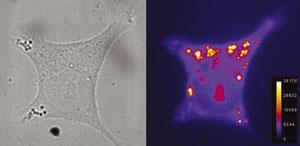Fluorescence studies show up zinc complexes in human cancer cells
The uptake of naturally fluorescent zinc complexes into human cancer cells has been investigated by UK scientists.
Thiosemicarbazones and their metal complexes have many uses in medicine - they can be antibacterial, antimalarial and antiviral. They also have antitumour activity. Despite this sustained interest from scientists, little was known about the distribution of these complexes in living cells until now.

Jonathan Dilworth and colleagues from the chemistry and clinical pharmacology departments at the University of Oxford have made a range of zinc bis(thiosemicarbazone) complexes. These complexes have an inherent fluorescence, allowing the group to monitor their absorption and distribution in a range of human cancer cells.
To measure the complexes’ uptake the cells were grown in a specially designed petri dish. A solution of the zinc complex was added to the cells and after one hour an image of the cell was taken. The cells’ shapes indicated that they were unharmed after the complex was added. Control experiments showed that the fluorescence could only be caused by intact zinc bis(thiosemicarbazone).
The zinc complex’s distribution within the cell depended on both the cell type and the nature of the zinc complex. In prostate cancer cells the complex was concentrated in a small area of the cell but in breast cancer cells the distribution is more uniform with a high concentration in the cell nucleus.
The group now aims to optimise the therapeutic and imaging abilities of these complexes.
Lorna Jack
References
<MAN>b417206a</MAN>






No comments yet